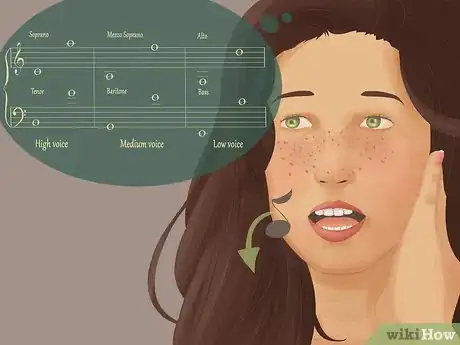This article was co-authored by Annabeth Novitzki. Annabeth Novitzki is a Private Music Teacher in Austin, Texas. She received her BFA in Vocal Performance from Carnegie Mellon University in 2004 and her Master of Music in Vocal Performance from the University of Memphis in 2012. She has been teaching music lessons since 2004.
There are 7 references cited in this article, which can be found at the bottom of the page.
wikiHow marks an article as reader-approved once it receives enough positive feedback. In this case, 92% of readers who voted found the article helpful, earning it our reader-approved status.
This article has been viewed 175,774 times.
While some people are born with a natural ear for music, melodies, and pitches, others struggle to sing in tune. If you have a hard time matching pitches, it is possible to develop your pitch recognition.[1] Through regular practice and heightened self-awareness, you might become a pitch-perfect singer!
Steps
Developing Your Aural Awareness
-
1Match pitches on a digital tuner, piano, or guitar. The ability to hear, recognize, and then match a pitch with your voice is a fundamental ear training skill. While some people have a natural ear, others can learn to develop pitch recognition. However, about 1 in 20 people are “tone deaf” (a condition called amusia) and cannot learn this skill.[2]
- Find a digital tuner, piano, or acoustic guitar. Digital tuners are ideal for this exercise because the tool tells you if you are too sharp or too flat. If you don’t have access to any of these tools or instruments, there are several vocal match websites and apps available for you to choose from.[3]
-
2Select a target note. A target note is the musical note that you wish to match in pitch. You can choose any note within your vocal range—you could start by trying to match pitch with the lowest "C" in your vocal range. As you move through the exercise, continue to pick random notes that fall within your vocal range and attempt to match their pitch.
- Play the target note on the digital tuner, piano, or guitar.
- Listen to the pitch carefully. Try to hear the note in your head. This ability to hear, or visualize, a note in your head is called auralizing. This skill is developed over time and through persistent practice.
- Sing the target note. If you are using a digital tuner, look at the screen to see if you have perfectly matched the pitch, if you are flat, or if you are sharp. If you are off key, slide your pitch up or down slightly until you perfectly match the pitch. This can be tricky and often takes a lot of practice.
- Once you have matched pitch, select a new target note and repeat the process.
- It may take you a while to find notes that are within your vocal range and you are comfortable singing. Don’t be afraid to experiment with notes in different octaves.[4]
Advertisement -
3Sing major scales. Scales are musical exercises that go up and down in a predetermined pattern. Major scales are the most predictable and familiar. When you sing scales, you can focus on mastering a specific technique, such as vibrato, overcoming a certain problem, like pitchiness, or increasing your vocal range.
- Play a major scale on a piano or acoustic guitar, find an online video of a major scale, or use an app to play one. The C Major scale is an excellent place to start. The C Major scale follows this pattern: C, D, E, F, G, A, B, C, C, B, A, G, F, E, D, C.
- Listen to each pitch and visualize the note in your head.
- Play the exercise and sing along. As you move up and down the scale, focus on matching and maintaining each pitch.
- After mastering one major scale, move on to another major scale. Repeat the process.
-
4Sing major arpeggios. Arpeggios, like scales, are musical exercises. Instead of moving up and down from pitch to pitch, arpeggios go up and down in intervals. Practicing arpeggios will not only improve your pitch, but they will also enhance your ability to jump from one pitch to another pitch as you sing.
- Play a major arpeggio on a piano or acoustic guitar. Basic arpeggios follow this pattern: 1, 3 (Major Third), 5 (Perfect Fifth), 8, 5 (Perfect Fifth) , 3 (Major Third), 1. Start with the C Major arpeggio. It follows this pattern: C (1), E (3, Major Third), G (5, Perfect Fifth), C (8), G (5, Perfect Fifth), E (3, Major Third), C (1).
- Listen to each pitch and interval. As you hear the notes, visualize the pitches and intervals in your head.
- Play the exercise and sing along. As you move up and down the arpeggio, strive to match and maintain each pitch. Pay particular attention to hitting each interval.
- After mastering the C Major Arpeggio, work on another Major Arpeggio. Repeat the process.
Correcting Your Pitch
-
1Stand in the correct singing posture. If you are struggling to sing on pitch, your posture may be to blame. When you stand in the correct posture, you will have an easier time producing the right pitch and controlling your voice. To stand in the correct singing posture:
- Place your feet slightly apart with one foot just in front of the other front. Transfer the weight of your body from your heels to your toes.
- Maintain a slight bend in your knees. Never lock your knees.
- Place your hands at your sides. Keep your hands relaxed.
- Your stomach should be flat and firm, yet expandable.
- Pull your shoulders back and down.
- Your chest should be held high.
- Keep your chin parallel to the floor.[5]
-
2Correct a sharp pitch. If you are singing sharp, you are singing above the intended pitch. This may be caused by tense abdominal muscles, a locked jaw, or lack of focus. You can correct for these problems by:
- Relaxing your muscles and softening your tone.
- Singing with less force.
- Monitoring your jaw for tightness and relaxing it when it begins to tense up.
- Working on your breath control.
- Monitoring your voice closely and remain focused.[6]
-
3Fix a flat pitch. If you are singing flat, you are signing below the target pitch. This may be caused by fatigue, inability to focus or support your breath, singing outside of your vocal range, relaxed facial muscles, or the inability to properly monitor your voice. You can correct your flat tone by:
- Improving your breath support.
- Visualizing approaching the pitch from above instead of below.
- Keeping your chin parallel to the floor.
- Raising your eyebrows and or smiling.
- Changing the key of the song.
- Monitoring your voice closely.
- Getting adequate rest before a performance or lesson.[7]
-
4Record yourself singing and listen to the recording. This is a great way to determine if you are on pitch, as it can sometimes be difficult to hear yourself while you're singing. Record yourself singing scales, arpeggios, or even a song, then play back the recording. Listen for notes that are off pitch so you can correct them the next time around.
Practicing Audiation
-
1Explore the concept of audiation. In the 1970s, Edwin Gordon developed the term audiation. The concept of audiation pertains to the concept of auditory imagery, or the ability to hear, or visualize, sounds in your head. In order to understand audiation, work through the exercise described below:
- Select a song that is incredibly familiar to you. It could be your nation’s national anthem or a song from your childhood, like “Twinkle Twinkle Little Star.”
- Don’t hum or sing this song. Instead, think about it—visualize the familiar melody in your head.
- The ability to hear this song in your head without humming, singing, or listening to it, is called audiation.
-
2Sing a familiar song out loud. Select a familiar song—it can be the same song you choose before. Find a quiet spot where you can focus and sing without being disturbed. Once situated, sing the song out loud. As you sing, commit the following to your memory:
- The melody.
- The pitch of each note.
- The intervals between each set of notes.[8]
-
3Sing every other line of the familiar song while visualizing the rest. When you feel confident in your knowledge of the song, enhance your audiation skills by visualizing a small portion of the song. Starting at the top of the tune, sing every other line out loud. When you are not singing, visualize the line of the song in your head.
- The first note of the lines you sing may be extremely challenging to sing in tune. As your audiation skills improve, however, you should be able to hit the note right away.
- Continue to count as you visualize the lines.[9]
-
4Sing only specific words of the familiar song while visualizing the rest. Once you have mastered singing and visualizing alternating lines, you can attempt a more challenging audiation exercise. Select a few words to sing from each line.
- Sing the first word of the song.
- Visualize the portions of the song that lie in between the words you have chosen to sing.
- Try your best to hit the correct pitch of the words you are singing.[10]
Expert Q&A
Did you know you can get expert answers for this article?
Unlock expert answers by supporting wikiHow
-
QuestionHow do I increase my voice pitch?
 Annabeth NovitzkiAnnabeth Novitzki is a Private Music Teacher in Austin, Texas. She received her BFA in Vocal Performance from Carnegie Mellon University in 2004 and her Master of Music in Vocal Performance from the University of Memphis in 2012. She has been teaching music lessons since 2004.
Annabeth NovitzkiAnnabeth Novitzki is a Private Music Teacher in Austin, Texas. She received her BFA in Vocal Performance from Carnegie Mellon University in 2004 and her Master of Music in Vocal Performance from the University of Memphis in 2012. She has been teaching music lessons since 2004.
Music Teacher
-
QuestionCan anyone learn to sing well?
 Annabeth NovitzkiAnnabeth Novitzki is a Private Music Teacher in Austin, Texas. She received her BFA in Vocal Performance from Carnegie Mellon University in 2004 and her Master of Music in Vocal Performance from the University of Memphis in 2012. She has been teaching music lessons since 2004.
Annabeth NovitzkiAnnabeth Novitzki is a Private Music Teacher in Austin, Texas. She received her BFA in Vocal Performance from Carnegie Mellon University in 2004 and her Master of Music in Vocal Performance from the University of Memphis in 2012. She has been teaching music lessons since 2004.
Music Teacher
-
QuestionCan you tune your voice?
 Annabeth NovitzkiAnnabeth Novitzki is a Private Music Teacher in Austin, Texas. She received her BFA in Vocal Performance from Carnegie Mellon University in 2004 and her Master of Music in Vocal Performance from the University of Memphis in 2012. She has been teaching music lessons since 2004.
Annabeth NovitzkiAnnabeth Novitzki is a Private Music Teacher in Austin, Texas. She received her BFA in Vocal Performance from Carnegie Mellon University in 2004 and her Master of Music in Vocal Performance from the University of Memphis in 2012. She has been teaching music lessons since 2004.
Music Teacher
References
- ↑ https://www.sciencedaily.com/releases/2007/08/070823214755.htm
- ↑ https://www.sciencedaily.com/releases/2007/08/070823214755.htm
- ↑ http://trainer.thetamusic.com/en/content/matching-pitch
- ↑ http://makingmusicmag.com/how-to-train-your-ear-for-perfect-pitch/
- ↑ http://cmed.faculty.ku.edu/gummposture/posture.html
- ↑ http://www.idiotsguides.com/arts-and-entertainment/singing/troubleshooting-vocal-problems/
- ↑ http://www.idiotsguides.com/arts-and-entertainment/singing/troubleshooting-vocal-problems/, http://www.taxi.com/transmitter/1205/three-ps-pitch-pocket-passion.html
- ↑ http://www.easyeartraining.com/learn/the-secret-music-practice-skill-audiation/
- ↑ http://www.easyeartraining.com/learn/the-secret-music-practice-skill-audiation/
About This Article
To sing on pitch, start by standing in good singing posture, with your chest held high and your shoulders pulled back and down. Then, practice matching your voice to a pitch on a piano, acoustic guitar, or digital tuner. Next, move on to singing scales, since they make it easy to hear when you’re a little off. When you feel confident with those, try some arpeggios, which are a little trickier because they jump from pitch to pitch. Finally, consider recording yourself as you sing, so you can play back the recording to figure out where you might need extra practice. For tips from our Music Instruction reviewer on how to fix your pitch if it’s sharp or flat, read on!









































































